(1766 - 1850)
Pioneer of the Fine Wool Industry
Elizabeth Macarthur’s critical contribution to the establishment of a local fine wool industry helped set the course of Australian prosperity, given the wool trade’s long-held significance to the national economy. Elizabeth worked tirelessly in her husband John’s long absences to preserve the strict stock control measures he had adopted, and drew on her strong administrative skills to manage her family’s estates.
Image: Reputedly Elizabeth Macarthur 1785-1790 watercolour on ivory miniature from the collections of State Library of New South Wales
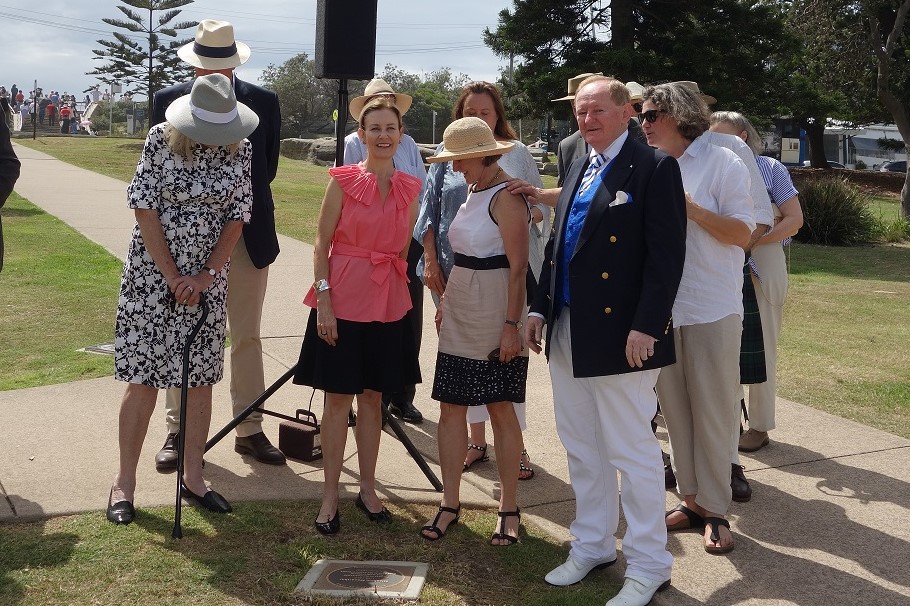
The Hon. Gabrielle Upton, MP, Mayor Clr Cavanagh and family members at the plaque unveiling, Robertson Park, Watsons Bay.
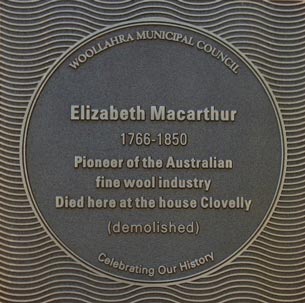
Date of plaque unveiling: 8 February 2019
A plaque commemorating Elizabeth Macarthur was unveiled near the site of the house Clovelly (now demolished) at Roberston Park, Watsons Bay, where Elizabeth spent her last summers. She died at the property on 9 February, 1850. The plaque is installed in the lawn near the Rotunda at the top of Robertson Park.
Gallery
Elizabeth Macarthur (14 August 1766 – 9 February 1850)
Pioneer of the Fine Wool Industry
Elizabeth Macarthur occupied an exceptional position in the early years of the penal colony of New South Wales, set apart as a woman of education, refinement, intellectual ability and principle in a brutal environment all but devoid of these attributes. While her circumstances gave her little common ground with the greater proportion of the population (numbering under 2,000 at the time of her arrival) they granted her an influential status within local leadership circles, albeit unofficial. Elizabeth’s natural grace appears to have ensured that this was a power she never exploited. The same quality raised her reputation above the consequences of manifold disputes provoked by her famously confrontational husband John, and which destroyed his relationship with a succession of colonial authorities and fellow colonists.
However, it is in what she did, rather than who she was, that Elizabeth Macarthur made her greatest contribution to the fortunes of the emergent ‘Australia’. Through her calm administration, perseverance and personal industry, Elizabeth enabled her husband’s vision and work to flourish through the founding of an Australian wool industry. Her work was to benefit not only the Macarthur family, but also the colony of New South Wales, and ultimately the nation which emerged from the colonial era. Elizabeth’s role in the process, always supportive, became an active one during John MacArthur’s two long absences abroad, the first of which came at a formative moment in the growing program which he had established. Elizabeth Macarthur’s part in the development of the Australian fine wool industry was publicly underestimated in her lifetime – and it is likely she was content with that outcome.
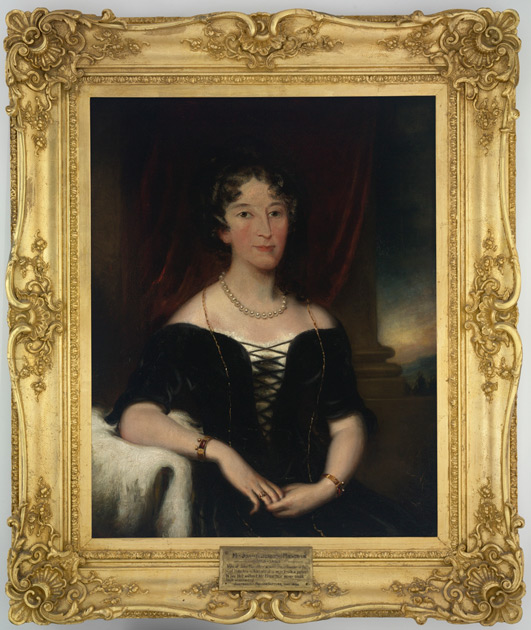
Portrait of Elizabeth Macarthur (Artist and date unknown), from the collections of the State Library of New South Wales (Dixson Galleries) DG221.
The impact of the Macarthur family’s activities upon the progress of New South Wales can scarcely be overstated. From the Napoleonic wars to the mid-20th century ‘wool boom’, the Australian economy profited handsomely from its graziers’ capacity to grow wool which competed favourably in all markets. From 1871 to the 1960s, wool was Australia’s main export commodity. During the 1950s, Australia rode high ‘on the sheep’s back’, the national wool trade delivering extraordinarily high living standards to the Australian people in the early post-war years. For all of this, the work of John and Elizabeth Macarthur had paved the way.
Elizabeth Macarthur’s other great legacy are her writings – both diaries and letters. A gifted writer, she drew on her natural powers of observation and description to capture the formative years of rapid growth and change from a perspective few others had the opportunity to hold. Her writings have provided the basis of several well-rounded 20th-century studies of her own life, but they also chronicle the history of the colony of New South Wales from 1790 to 1850, in which respect, for historians and researchers, they remain an invaluable resource.
Family background
Elizabeth Macarthur was born on 14.8.1766 at Lodgeworthy,her father’s farm on the edge of the village of Bridgerule, on the banks of the Tamar River in Devon. According to present-day accounts of the district associated with Elizabeth Macarthur’s childhood,i the farm and farmhouse survive today, as does the vicarage attached to St Bridget’s Anglican Church Bridgerule, where events from the first decade of her life determined that Elizabeth would spend much of her childhood and youth, and receive the education which stood her so well.
Richard Veale, Elizabeth’s father, held the status of yeoman farmer, as did Elizabeth’s maternal grandfather, John Hatherley, father of her mother Grace. A present-day photograph of Lodgeworthy posted online by a current biographer of Elizabeth Macarthur,ii shows a neat farmhouse, not especially substantial nor grand in its design, and wholly surpassed in scale and style by the house built by Elizabeth’s husband, John Macarthur, at Camden in New South Wales. Nevertheless, the Lodgeworthy pictured is solidly constructed and suggestive of permanence and financial stability. The family into which Elizabeth was born was, in the words of one biographer, ‘apparently of some education and affluence;’iii by others she is described as the daughter of a ‘landed gentleman’.
Writing to a childhood friend, ten years after her marriage, Elizabeth commented that friends and family had considered the young John Macarthur, her choice of husband, as 'too proud and haughty for our humble fortune'.iv The observation was perhaps delivered in irony, as John was at that stage a young soldier with drive and prospects, but no immediate assets, and his father was a Plymouth-based draper, and hence ‘in trade’. Money thus raised had given him an education and, in October 1782, bought the 16-year old John his commission as an ensign in a corps bound for the American war - the first step in a circuitous route which led to New South Wales and finally, a fortune and status which gratified John’s sense of destiny.
John never lost sight of the fact that prior to the Battle of Culloden (1746), when his grandfather and uncles had been killed, his family dispossessed, and his father forced to flee abroad, the Macarthurs had held lands and been part of a distinguished clan of long lineage. It was a pride which he was perhaps a little too ready to defend, and to display, leaving him open to ridicule and provocation in the irreverent world of New South Wales.
As for Elizabeth Veale, while born into landed status, she was, when John met her, a fatherless young woman with no marriage settlement to be offered in her name. As has been commented, neither John nor Elizabeth married for money.v
Education and occupation
When she was just six years old, Elizabeth Veale’s father Richard died. It was the second death in her immediate family in less than a year, her younger sister having died three months earlier. Her mother Grace remarried, the Lodgeworthy property passed into the hands of a male relation under the terms of the estate, and Elizabeth (the only surviving child of her mother’s first marriage) went to live with her grandfather, John Hatherley. This was presumably a practical solution, and should not be interpreted as an estrangement between Elizabeth and her mother, with whom she continued to correspond faithfully after she left England for New South Wales, and whom she sadly regretted never having seen again following that departure.vi Her grandfather John, who cared for her, was also fondly remembered by his adult granddaughter.
With her father’s death, and even perhaps before it, Elizabeth appears to have spent much of her time during childhood and youth at the Bridgerule vicarage. By the time of her marriage she was seemingly absorbed into the household of the Reverend John Kingdon, Vicar of Bridgerule. Family sources suggest that Kingdon had long been a friend and priest to Richard and Grace Veale and John Hatherley, but it has also been speculated that these circumstances had a basis in an agreement between the vicar and John Hatherley that Reverend John Kingdon, an MA and former Fellow of Exeter College, Oxford would take on Elizabeth’s education.
Elizabeth was the same age as Bridget, the eldest daughter of the Kingdon family, who was to be a lifelong friend and correspondent after Elizabeth’s move to New South Wales. After her departure from England, the Kingdons took a kindly and protective interest in Elizabeth’s elderly mother, and in the Macarthur’s eldest son Edward when he returned ‘home’ at five years old, quite alone, for schooling. All this suggests a very close relationship between the Veale and Kingdon families.
Elizabeth’s writings reveal her love of literature and exposure to a good library, which the Reverend John Kingdon would almost certainly have kept. As a result her journals and letters are invested with all the qualities which make them useful historical documents. Her sound education also allowed her to handle the complex affairs of her husband’s pastoral interests, and enabled her to meet the urgent necessity - given she found herself in a colony without schools or educators - of providing the initial schooling of her own children. She taught her sons and eldest daughter Elizabeth until they were old enough to be sent to England to receive their formal education, while her younger two daughters, Mary and Emmeline, were schooled as she herself had been on the other side of the world, in their own home, firstly under their mother’s tutelage and then by the family’s English governess, Penelope Lucasvii. In short, Elizabeth Veale gained an education which served both her, and her family, well.
Wife and mother – early years
It is believed to have been through the Kingdon family that John Macarthur and Elizabeth Veale met, and thus began a marriage and a complete partnership, terminated (and on John’s part only) by his descent into mental illness in his last years. Elizabeth remained a devoted wife until John’s death, forty-six years after their marriage at Bridgerule, and a world and many extraordinary experiences apart from it.
When they met, John’s financial position was indeterminate. The commission obtained for him in the Corps of Foot assembled under the command of Major Benjamin Fish was in jeopardy before it began, as the war in America ended before the Corps could be despatched. The Corps disbanded, and John was reduced to half-pay. It was these circumstances which apparently brought John into the ambit of the small world of Bridgerule and provided the opportunity for his meeting with the young Elizabeth Veale. That the Kingdons were mutual friends of some longstanding would seem confirmed by the fact that five months before John and Elizabeth’s marriage, each had taken on the responsibilities of godparent to the Kingdon’s daughter, baptised Elizabeth on 2.5.1788 at St Bridget’s Bridgerule. It would have been a mark of considerable respect to them both, and an honour not bestowed lightly by a clergyman.
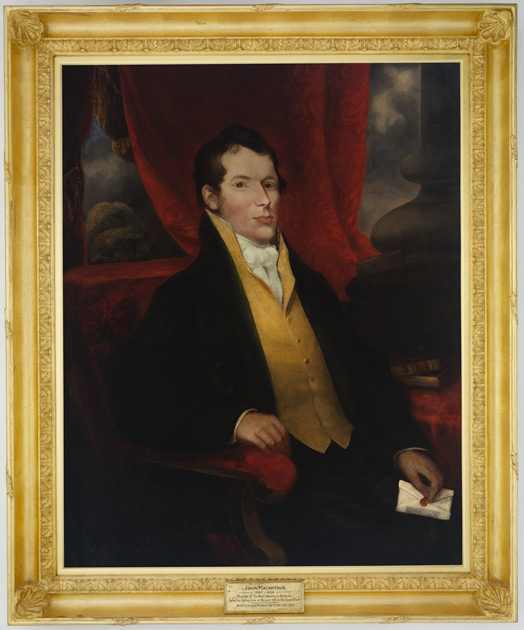
Portrait of John Macarthur from the collections of the State Library of New South Wales, Dixson Galleries DG222.
Their marriage by licence on 6.10.1788, with ‘John Kingdon, vicar’ named as the celebrant, is recorded in the Parish register of St Bridget’s. John at the time of their marriage was earning his commission, now at full pay, in a recruitment drive in the towns and villages of the area. Their first child, named Edward, was born in Bath the following March as the couple travelled to London,viii the only one of their offspring born in England.
Soon after, John Macarthur was himself recruited, accepting the offer of a position involving promotion to Lieutenant, in a new unit, the 68th Regiment of Foot, better known eventually as the New South Wales Corps or, in Australian history’s vernacular, as the ‘Rum Corps’. The overture came from Evan Nepean, a former school friend who, as under-secretary of state in the Home Department, had oversight of various matters in Sydney ix. The unit then under formation was to serve as the replacement force for the detachment of marines initially assembled to keep order in the penal colony. Nepean’s younger brother Nicholas was to take charge of the first detachment of the Corps, and to act as its commanding officer in the colony until Major Francis Grose could be despatched to take up office. Nicholas Nepean was also known to John. However, by the end of the voyage to New South Wales, the relationship between John Macarthur and the younger Nepean brother was fractured.
Elizabeth may have had private reservations about the decision John had taken – the distance, the unknown, the effects of the voyage and of life in a remote, under-resourced colony upon her delicate firstborn child. However, as she would always do in her married life, she offered unwavering support to her husband and his ambitions. Besides, early reports from the colony of New South Wales, in a communications system which inevitably lagged many months behind reality, were encouraging. In October 1790, a month before embarkation, Elizabeth had written confidently to her no-doubt worried mother:
We learn that wheat which has been sown flourishes in a manner nearly incredible, and that the Settlers are making rapid progress in building; so that by the time our Corps arrives everything will be made comfortable for our reception.
(King, Hazel. Elizabeth Macarthur and her world pp. 9-10)
Elizabeth Macarthur was destined to be a firsthand witness to many of the momentous episodes of colonial history, her writings the richer for her perspective. Setting this precedent was her passage to Sydney, in which she had the misfortune to sail, along with her husband and infant son, with the notorious Second Fleet, the first three months of the voyage spent on the Neptune, described as ‘the worst vessel in the worst convict fleet’ in the history of transportation to New South Wales.x Due to shocking conditions which included overcrowding, deliberately withheld rations, and unchecked ill-treatment, one third of the convicts despatched on the Neptune would die during the voyage.
Lieutenant Macarthur was one of five regimental officers of the New South Wales Corps supporting the master of the ship, and the only one accompanied by a wife and child. To his dismay, he found their allotted quarters were located on a lower deck, unlike the well-aired cabins off the upper deck given to all other officers aboard. Worse, their makeshift ‘cabin’ was formed by an improvised partition separating their space from one holding a group of convict women. The appalling conditions adjoining them were concealed from the Macarthur family in view only. These arrangements, along with other injustices inflicted upon fellow members of his regiment by the ship’s hierarchy, were interpreted by Macarthur as a deliberate slight to his honour and that of his family and fellow officers, and he repeatedly argued and advocated on his own and their behalf. During the first stage of the voyage, as the ship hugged the Devon coastline and Elizabeth penned a homesick farewell to her home,xi her husband and others left the ship, where he fought a duel with the ship’s master, Captain Thomas Gilbert.
It was not the last duel which Macarthur would contest, and it was a reaction which varied in degree only from his usual intemperance when faced with injustice or insult – real or perceived. But for Elizabeth it was perhaps a first glimpse of what life with John Macarthur could hold.
Matters deteriorated further onboard the Neptune. Distressingly, it became clear that malice motivated certain of the actions of the naval officers. A change of master provided no relief, the replacement being Captain Donald Traill, whose cruelty and self-serving opportunism were later more widely exposed in the procedural ramifications of the disastrous voyage. Under Traill’s command, the Macarthur family was sidelined - forced to eat in their cabin away from the other officers, with rations successively reduced, and Elizabeth’s separate passage to the upper deck was boarded up, forcing her to negotiate a path via the unmanaged filth of a sick-bay to her only opportunity for fresh air. Macarthur was involved in further quarrels, both with the ship and his superior officer Nicholas Nepean. Eventually the family was transferred to the Scarborough,where conditions were milder and their onboard reception benign.
Episodes of illness now threatened both Edward and John – John never fully recovering. Elizabeth experienced her own suffering - childbirth in the most adverse of circumstances. In a letter to her mother, dated 18.3.1791, she recalled the event thus: ‘thrown into premature labour & delivered of a little girl who lived for but an hour.’xii
The voyage ended for the Macarthurs when the Neptune and the Scarborough both entered Sydney’s heads on 28 June 1790. Elizabeth, however, had kept a journal, so that details of the days at sea could be recalled at will. Lodged now in the Mitchell Library, her words are a permanent testimony of her personal experience of the unrestrained ruthlessness and corruption of the system.
Early role in colonial life
While her expectation was to return to England once her husband had secured sufficient promotion to further his career there, this was not Elizabeth Macarthur’s destiny. Instead of the anticipated three year stay in New South Wales, her life in the colony spanned sixty, and saw momentous change, much of it documented though her writings.
Elizabeth arrived in 1790 to a settlement quite unlike that portrayed in the accounts she had read before departure. Far from flourishing crops, she found settlers in the grips of malnutrition, and the first house provided to her family was a wattle-and-daub thatched hut. If she was shocked by the contrast between reality and report, she was nevertheless undaunted. Her writing shows that she threw herself into the activity of understanding, and more importantly appreciating, the entirely foreign environment of her surroundings.
She studied the landscape and the native plant life of the Sydney region on her walks, explored the harbour with her husband in free moments, and continued her keen interest when the family was posted for a time to the fledgling community at Rose Hill (Parramatta) - little realising then the importance which this locality would hold in their lives. Due in no small part to Elizabeth’s efforts and likeable personality, the Macarthurs gathered around them a circle of friends drawn from among the officers of the colony. And in every temporary place she settled, in the first ‘mud hut’ and later in a small brick residence, Elizabeth established domestic order and created a sense of home.
The Macarthurs were soon part of the social life of the first New South Wales establishment. The first Governor of the colony, Arthur Phillip, held Elizabeth in high esteem, and she was included in government house circles then, and later. While it has been written that :
The only governor who was free to enjoy her society was Arthur Phillip, for in later years her husband's political position was too controversial for any governor to seek the company of the Macarthur family.
(Conway, Jill Australian Dictionary of Biography)
it would seem that these exclusions were intermittent rather than permanent. Elizabeth enjoyed a sound friendship with Elizabeth Macquarie, and earned the regard of her husband Lachlan, fifth Governor of New South Wales. An 1819 Government House guest list in Elizabeth Macquarie’s hand, reproduced in a 2011 edited collection of her letters, shows the entire Macarthur establishment as prospective invitees to what is believed to have been a ball held in honour of Queen Charlotte’s 75th birthday.xiii Listed by Elizabeth Macquarie were Mr Macarthur [John], Mr H Macarthur [Hannibal, John’s nephew]; Mr J Macarthur [James, third son of John and Elizabeth] and Mr W Macarthur [William, fourth son of John and Elizabeth]. The only unlisted of John and Elizabeth’s sons were Edward and John, both pursuing careers abroad.
Elizabeth’s major contribution to colonial life, however, came later and was not social, but practical. It arose from two periods of exile for her husband (1801-1805 and 1809-1817) during which she was required to take on the responsibilities of work which her husband had begun and then abandoned for reasons beyond his control. In bringing his schemes to fruition she was challenged to draw upon all her personal resources.
Advancement of the Macarthurs under Grose
The arrival in the colony in February 1792 of John’s commanding officer Major Francis Grose, led to a great material improvement for the Macarthur family – the first steps to putting John Macarthur’s feet on the path to claiming the status he always believed befitted his family background. Grose had been appointed lieutenant-governor of New South Wales and commandant of the New South Wales Corps in 1789, but it was eighteen months after the first detachment of his men had been sent abroad that he actively took up his role in Sydney. Under Grose, the position of the military would be cemented in the colony, much to the advantage of its members.xiv For John Macarthur, new positions and responsibilities meant not only generous pay increases (which in themselves underpinned the betterment of his family’s situation) and enhanced local status, but also fresh opportunities and broadened horizons.
More importantly – given the family’s pastoral future, and Elizabeth’s comfort - was a land grant of 100 acres at Parramatta, received by Macarthur in 1793, when Grose served as Lieutenant-Governor, in the two-year interval between the departure of Philip and the installation of Governor Hunter.
This gift of promisingly arable land with some precious livestock (a cow in calf) meant for Elizabeth the establishment of a permanent house where her children (who at that stage numbered two, firstborn Edward and a sister Elizabeth born in 1792) could be raised in a pleasant home and a healthy environment with plentiful, nourishing food. Elizabeth had despaired at the soil quality in the Sydney Cove area, and its unsuitability for raising vegetables, observing ‘beauty being only skin deep’, with reference to a landscape which so appealed to her finely tuned aesthetic senses, but failed to reward in the practical business of vegetable growing.xv At Parramatta, the estate established by the Macarthurs flourished with diverse produce and livestock, its management eventually earning its custodians further land allocations, and the beginnings of their pastoral empire.
Naming his Parramatta grant Elizabeth Farm to honour his wife, Macarthur set about at great pace clearing the land for cultivation and building the family home. The first use in the colony of a European plough, horse drawn, is said to have been at Elizabeth Farm.xvi While he obtained the use of convict labour as allowed, Macarthur also paid men who had served their time, and there is evidence to believe that he treated all men in his employ fairly. xvii Elizabeth Farm under John’s vision and industry was soon under heavy and diverse cultivation, and boasting a dairy.
A small brick house was built, and over the years both the acreage and the house expanded as Macarthur’s stocks rose and more children were born – six between 1794 and 1808, all at Elizabeth Farm: John, Mary, James (who did not survive infancy) a second child named James, William and Emmeline.
While the later Camden estate was far larger,xviii and the house that was built on it far grander and the work of no less an architect than colonial favourite John Verge, it is generally acknowledged that Elizabeth Farm occupied a special place in Elizabeth Macarthur’s heart. Despite her children’s later urging for her to move to the new house at Camden Park, completed just as John died, and where her two younger sons had taken care and custody of their father in his period of mental illness, she refused, returning to Elizabeth Farm – from which John had banished her in a state of delusion - and made it her home until her death.
Elizabeth had been left the use of the house in her husband’s will, which in patriarchal form left the ownership of the estate to her absentee landlord son Edward, as the eldest male descendent. The house today has a significance beyond Elizabeth’s affections for it - in heritage terms, the original four-roomed brick cottage at the centre of later additions is acknowledged as the oldest surviving European homestead in Australia.
Elizabeth Farm also saw the beginnings of the Macarthur’s wool growing activities. In 1798, an account written by Elizabeth to Bridget Kingdon of the family’s property – now increased in extent to almost 500 acres - told of 120 acres under wheat, an abundant vegetable garden and orchard. Of livestock, she writes of hogs, 50 head of cattle, a dozen horses and 1,000 sheep.xix While the latter were initially intended for mutton, John began to selectively reserve animals for breeding purposes, thinking not of meat but of wool.
John had also begun to experiment with cross-breeding, and produced from a mix of Indian and Irish rough-haired sheep ‘a mingled fleece of hair and wool’.xx In this result he saw the potential for improving the yield by manipulation.
MacArthur’s vision for wool growing on his burgeoning estate was grounded in his appreciation that the colony of New South Wales needed an export trade to survive. As he would later expound to the English authorities:
This small population, located at so vast a distance from other civilized parts of the globe, can have no prospect of success unless it can raise the export of some raw material in considerable demand, which can be produced with little labour and be capable of bearing the expense of the longest sea voyage. Only by that means can the people escape the occasional threat of scarcity of bread.
(MacArthur, John Memorial to Lords of the committee of the Privy Council London, January 1804)
It is said to have been the sight of some Spanish merino sheep, unloaded in Sydney by Captain Henry Waterhouse and Lieutenant William Kent after a supply run to the Cape of Good Hope in 1797, that gave Macarthur further impetus for studying fine wool as the ideal niche produce for export. His foresight and understanding were to be handsomely rewarded, although he did not live to see the full extent of his vision achieved.
The merino imported to New South Wales by Waterhouse and Kent were of the closely guarded ‘royal’ line – originally the gift of Carlos III Spain to Prince William of Orange of the Netherlands, on whose estates they had failed to thrive. In 1789, Colonel Robert Jacob Gordon, Commander of the Cape Garrison for the Dutch,xxi had been charged with introducing the merino to this far flung Dutch territory, in an attempt to replicate Spanish conditions in Africa. Gordon, an explorer and soldier, had been known to members of the Sydney buying contingent, but his period at the Cape had come to a close before their expedition. In 1795, when the Cape had been seized by the British, Gordon had suicided in disgrace. Waterhouse and Kent, finding the merino were in the hands of Gordon’s widow when paying their respects to her, had purchased the sheep at £4 per head on behalf of the colony of New South Wales, after John Palmer, in charge of the live-stock buying, had shown no interest in acquiring them.
In Sydney, it is claimed that Macarthur, immediately recognising the potential of the merino fleece, offered 15 guineas per head for the sheep on the spot.xxii This was initially refused by Waterhouse on grounds that they must first be offered to the governor, but when the Governor showed no interest, the merino grazed for some time at Waterhouse’s propertyThe Vineyard, apparently ‘with none but Spanish rams with them’.xxiii
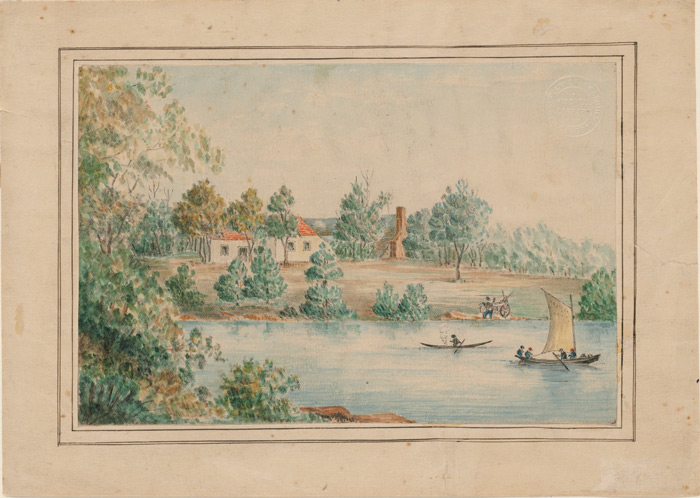
Captain Waterhouse's house, Sidney [sic], the Vineyard, about 1798. Image from the collections of the State Library of New South Wales (Mitchell Library)
Over time, the merino were dispersed in small numbers throughout the colony, John Macarthur receiving two rams and five ewes. Then, when Waterhouse found himself recalled to England in 1800 due to the Napoleonic threat, the opportunity arose for Macarthur to acquire more. While a number of colonists now held merinos, Macarthur alone of these recipients recognised the prize he held, and while cross breeding would later serve his purposes, in the first instance he cautiously, sensibly and meticulously kept the merino strain pure. This was the beginning of his stud.
Unlike Elizabeth, her husband made two return trips to his native land - neither initiated of his own volition, but astutely used to his own advantage in cultivating powerful friends and patrons in England, and promoting his interests in the colony. The first of these ‘journeys’, in 1801, was occasioned by the irregularities in the conduct of a duel which John fought with his Commanding Officer, Colonel William Paterson, whom he wounded. John was arrested, and sent to England by Governor King for court martial.
He returned to New South Wales in 1805, no longer a member of the regiment, but on his own terms. The administration in England, having determined that his case could never be properly investigated in England, ordered his return to his regiment in New South Wales. Macarthur, however, separately appealed to a new and powerful champion, Lord Camden,xxiv and secured permission to resign his commission and to return instead to further the development of a colonial wool industry in New South Wales. He sailed into Sydney harbour on 8 June 1805 in his personal quest for a golden fleece, on a whaling ship named Argo and in which he owned a half-share.
Accompanying Macarthur were wool experts who would eventually make encouraging reports to Governor King about specimens of wool found in the colony, based on the Macarthur flocks and one ewe belonging to the Reverend Samuel Marsden :
The specimens of wool grown [in the colony] … satisfy me that, with due care and attention to propagate from the pure race of Spanish sheep until sufficient numbers of them can be raised … the whole of the wool would in a few years become equal quality to the very best that is obtained from Spain.
(Edward Wood – quoted in Bickel, Lennard p. 124).
Macarthur’s status was now in every way changed from the man who had left Sydney in 1801.
Nevertheless, John Macarthur’s new position and sway did not give him immunity from all authority and process, and John’s second exile, occasioned by his involvement in the infamous rum rebellion, a military coup which deposed Governor Bligh, took him away from his colonial home for twice as long as his first absence.
During both these periods of her husband’s absence, Elizabeth added the management of the Macarthur pastoral estates to her duties of keeping a house and raising her family. John’s acquisition of the property he named Camden, the result of lobbying on his first return to London, extended her responsibilities during his second. While the true merinos, the ‘home flock’ of approximately 300, were retained at Elizabeth Farm, between 3,500 and 5,500 sheep were at various times grazed on the larger estates. Elizabeth was forced to travel regularly to consult the Camden Park overseer, keep records, supply returns to Macarthur in London and confer with him as to actions required - and then see that these were carried out.
Travel through the undeveloped areas which separated Elizabeth Farm from Camden Park was arduous, and in this period Camden Park was not yet equipped to welcome the traveller as it would later be – with all the resources of a great estate with a well-appointed villa. Moreover, the journey was not without inherent danger from escaped convicts and aboriginal warriors, just as there was ever-present danger at the more remote property itself, with the sheep watched day and night by shepherds to protect them from both natural predators and theft. Workers from the Macarthur estate were killed during 1816 within a period of particularly fraught relations between settlers of the Cumberland Plain and members of the Muringong and the Gandangara peoples, the situation reaching a head in the military reprisals ultimately ordered by Macquarie, now recognised as the Appin massacre, 1816.
These troubles were not Elizabeth’s first experience of having her own and her household’s safety placed in jeopardy in the absence of a husband. In 1804, when the convict uprising known as the ‘Battle of Vinegar Hill’ erupted in the district, she was fortunate in being a visitor at the Reverend Marsden’s house – and was escorted with the Marsden family to Sydney and safety. She learned later that, had she been at home, the rebels had considered her property a natural target, planning to torch her house to draw men from the local garrison to Elizabeth Farm in anticipation of the soldiers’ quick response to defend a lone woman.
Aside from danger, the work for Elizabeth was physically punishing. Governor Macquarie’s journal records a tour of the ‘Cowpastures’ (Camden) region in 1810, where he was astonished to find Elizabeth toiling beside the shepherds and shearers, supervising convict and ticket-of-leave men in the culling and shearing of sheep and the sorting and baling of wool – her quarters for the visit, a single-room bark hut.xxv
While stoic, Elizabeth did express in more intimate correspondence her longing for male support as she negotiated, as a woman, the male-dominated world of agriculture and business – hitherto quite unknown to her. Her husband’s nephew Hannibal had returned with John to New South Wales in 1805 to worked beside Elizabeth – but he was also frequently absent on excursions necessary to the business. Writing to her god-daughter Eliza Kingdon in 1816, Elizabeth confided:
My cares are many and anxious and I have so long been deprived of assistance from any male branch of the family that I cannot say I am comfortable or happy.
(Letter from E.M. to Eliza Kingdon, March 1816, quoted in King Elizabeth MacArthur and her world p.75)
Macarthur’s undisputed title of founder of the Australian fine wool trade was in no small measure due to his wife’s administrative abilities, diligence, and energies. A biographer has written of this second period of Elizabeth’s oversight at home:
In these years, because of her remarkable ability in the management of the sheep, John Macarthur's enforced absence was converted into an advantage in the development of his plans for the colonial pastoral industry. His presence in England and Elizabeth's in the colony surmounted the otherwise almost insurmountable problem of communications in developing the colonial flocks at precisely the most delicate point in their growth. During these eight years under their joint direction the wool of the Macarthur merino flocks managed to enter competitively into the British market and to establish the reputation of the colony of New South Wales as a centre for wool-growing. A great part of the achievement was that of John, with his flair for publicity, his astute direction and his unfailing economic vision, but a significant proportion of it was Elizabeth's, since her determination and administrative ability overcame the first and most formidable practical obstacles, which were within the colony, to the export of wool.
(Conway, Jill ‘Macarthur, Elizabeth (1766–1850)', Australian Dictionary of Biography)
It was Elizabeth who during this time had coordinated the despatch of Australia’s first commercial shipment of wool, in 1812 building on the earlier, tentative despatch of a single bale in 1807. It was the genesis of an industry that would shape the history and culture of Australia for decades to come.
John Macarthur’s recognition of his wife’s contribution, in a letter to Lord Bathurst, while muted, is recorded nevertheless:
I have had the good fortune through the prudent and able management of Mrs Macarthur to continue my establishment there [New South Wales] until the principal obstacles I had to encounter in my breed of sheep have been overcome.
(Letter from J.M. to Bathurst 1.8.1816, quoted in King Elizabeth Macarthur and her world p.79)
Final days of John Macarthur
Agreement was eventually reached with the British authorities that John Macarthur might return to New South Wales in return for a pledge that he would not seek involvement in public affairs. He brought home with him his two younger sons, James and William, now completed their studies and ready to take on a role in managing the estates.
In England, the Macarthur’s second son John, who had pursued a legal career in London, took responsibility in England for the family’s interests. In 1824, acting on his father’s vision, he brought to fruition the founding of the Australian Agricultural Company to further the prospects of an Australian Wool industry, funded with British investment. In New South Wales, John’s younger brother James Macarthur was part of a colonial advisory committee to the company, as was James’s cousin Hannibal Macarthur, Hannibal’s brother-in-law Phillip Parker King, and Dr James Bowman, husband of James’s sister Mary. The company still functions today, its scope having evolved with market changes.
Despite his pledge to forgo a career in public life, John Macarthur accepted appointment to the NSW Legislative Council in 1824, and again in 1829 to the reformed Legislative Council, on which he continued to serve until 1832 when ill health made his position untenable.
John Macarthur’s final years were clouded by descent into a deep depression interspersed with periods of frenetic but unfocused activity, and outbursts of threatening rage, the latter which ultimately could not be ignored by his family. He banished Elizabeth from Elizabeth Farm on grounds of an imagined infidelity, and for a period she lived with her married daughter Mary, wife of Dr James Bowman, and their children.
John was eventually declared insane and placed in the care and custody of his two younger sons, James and William, who supervised him at Camden Park. Here, when capable, he took an interest in the large house which he had ordered to be built by John Verge. While he died before it could be occupied, the knowledge of its imminent completion, as a final, tangible affirmation of his status, presumably brought him peace. John Macarthur was buried at Camden Park,where his wife would join him, beneath a family monument, after sixteen years of widowhood.
If Elizabeth Farm was a favourite home for Elizabeth Macarthur, she was to develop a great affection for another of the Colony’s early houses – a marine villa at Watsons Bay, which in the final years of her life, drew her to this maritime village for two idyllic summers.
Elizabeth was no stranger to Watsons Bay, and the first of the family’s seaside picnics in Sydney had, by chance, been held there – chance because, as she explained in a letter to Bridget Kingdon in March 1791, in ‘a harbour so formed’ there were so many pleasant possibilities to choose from. Elizabeth had been impatient to explore the waterfront, and their first opportunity for an excursion - given John’s continuing illness in the winter and spring days after their arrival, followed by the shock of their first experience of a Sydney summer’s heat - was in the early autumn of 1791 :
I have been enabled to put but one [excursion] in execution, and that was to a Bay near the harbour's mouth, about six miles from Sydney. We passed the day in walking among the rocks and upon the sands very agreeably. I looked carefully for some shells for you but could find none better that what you get at Bude or Widemouth. Above this Bay, about half a mile distance, is a very high hill which commands an extensive view of the wide ocean, on it is placed a Flag-staff which can also be seen at Sydney. When a ship appears the Flag is hoisted, by which means we have notice of it much sooner than we otherways [sic] could have; it also conducts the vessel into the harbour. There are a few huts near the Flag-staff with people in them appointed to keep a look-out, and from thence the spot has derived the general name of Look-out.
(Letter from E.M. to Miss Kingdon 7.3.1791, quoted in Some Early Records of the Macarthurs of Camden /ed. Sibella Macarthur Onslow.)
In 1791, Clovelly, the house which later would mean much to Elizabeth, was not yet built, and the few huts of the men stationed at the colony’s Look-out post were the only domestic structures in the locality. In the late 1840s, when Elizabeth Macarthur spent her two summers there, Watsons Bay was a changed place. The Look-out post was now the site of Mortimer Lewis’s sandstone octagonal two-storey towerxxvi and substantial marine villas dotted the small valley now known as Robertson Park, where the original huts of the Look-out men had once been situated.
Clovelly was one of these villas, located at the eastern end of present-day Robertson Park, on the highest part of the land associated with it, and commanding a view across the harbour towards the Sydney settlement. The house had been built by Thomas Watson, but it was Elizabeth’s nephew-by-marriage, Hannibal Hawkins Macarthur, who introduced her to the property, and granted her its use in the summer of 1847.
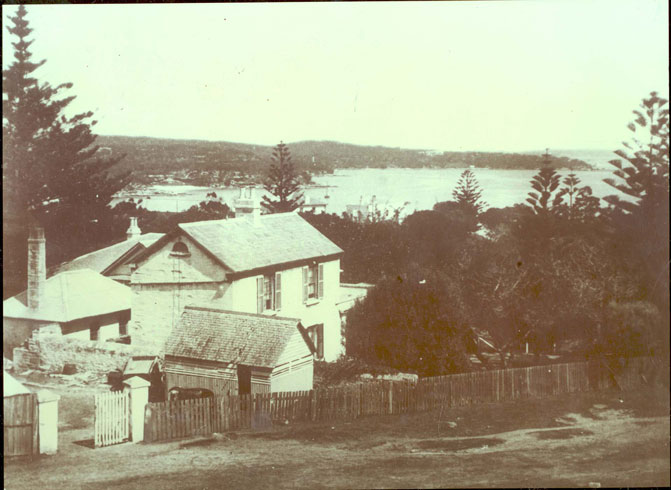
Clovelly, Watsons Bay. Woollahra Libraries Digital Archive pf002908
Watson, the property’s first owner, was a former master mariner who had worked as a pilot at Watsons Bay from 1822, and in 1834 been granted a parcel of 2 acres 2 roods, running from the harbour foreshore to the area known as ‘The Gap’. Watsons’s land had been bound by Edward Laing’s 20 acre grant to the north (Green Point) and to the south by 3½ acres issued to fellow pilot Richard Siddins, and the site of Siddins’s villa, today known as Dunbar House.
Thomas Watson may have built on his land prior to receiving formal title to it, since he advertised his villa for sale in August 1835 - apparently without success, given it was again on offer in late 1837. Described in 1835 as a ‘beautifully chaste and neat marine villa’ of 6 rooms and kitchen, the property included stables, coach house, 3 cellars and a ‘well-stocked garden in full cultivation’,xxvii this last suggesting some considerable period of establishment prior to the sale. By 1837, the house was described as ‘an elegant Italian villa.’xxviii Hannibal Macarthur paid £1,800 for the Watson property.xxix
Hannibal Hawkins Macarthur was the son of John Macarthur’s older brother James, born 1788 in Plymouth, and persuaded to immigrate with his uncle John on the Argo in 1804. Hannibal worked for his uncle, both on the estates beside Elizabeth Macarthur, and in trading abroad in sandalwood and other commodities. In 1812 he married Anna Maria King, daughter of Philip Gidley King, third governor of New South Wales, and the following year purchased The Vineyard, the property on the Parramatta River where, in Captain Waterhouse’s ownership, the first merinos in the colony had temporarily grazed. Hannibal paid £160 for the house and land and wrote to his uncle ‘I have purchased as a place of residence Waterhouse’s farm.’xxx The land was situated in present-day Rydalmere.
Hannibal was successful in his own right in his colonial business dealings, and in the mid-1830s set about replacing the existing house on his riverside property with a substantial Greek-revival house, designed by John Verge - the eastern elevation reputedly a replica of the Petit Trianon in Paris.
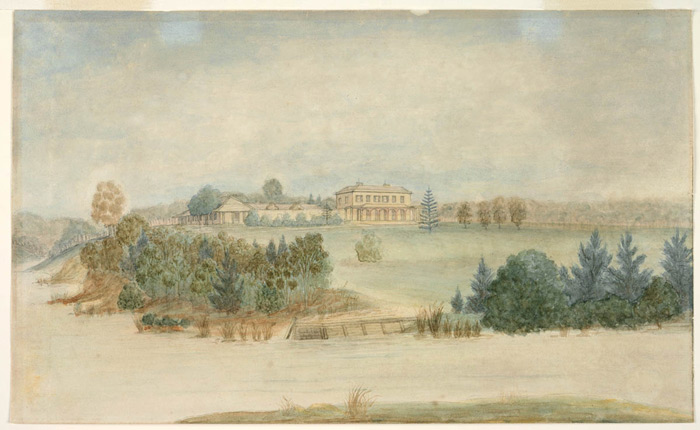
View of Vineyard, Parramatta, ca. 1851-1858 from the collections of the Mitchell Library, State Library of New South Wales FL3164231
The work at The Vineyard was completed by 1836, leaving Hannibal to contemplate securing a ‘seaside’ escape for his family, as a retreat from the heat of the inner west.
Having purchased Watson’s villa, Hannibal named it Clovelly, after a seaside town in Devon, a similar haven in the locality of his birth. The name would no doubt have been equally nostalgic for his Devon-born aunt-by-marriage, Elizabeth.
The use of the Clovelly property was offered to Elizabeth MacArthur during the summer of 1847, after she had suffered a period of ill health. Travelling by chartered steam boat down the Parramatta River and across the harbour, she arrived to stay at Clovelly with her youngest daughter Emmeline, now Mrs Henry Watson Parker,xxxi and so began the first of the two summers which brought Elizabeth to Watsons Bay. The arrangement was endangered by Hannibal’s insolvency in 1848, but cemented when Elizabeth’s son-in-law, Henry Watson Parker, purchased the property. It was given over to restoration during that summer, but Elizabeth and Emmeline returned, in 1849.
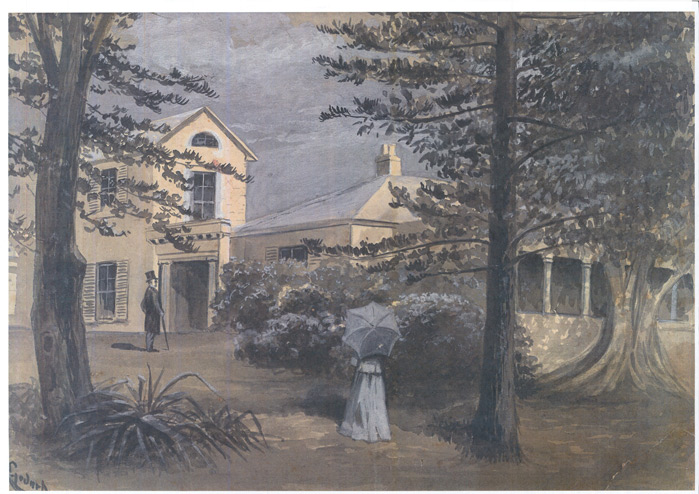
'Clovelly', Watsons Bay. Watercolour by F. Godart. Original held in a Private Collection.
Elizabeth Macarthur’s letters speak of gentle walks throughout the area, conversations with the local fishermen and pilots and others of the maritime community, pleasure in the sound of ‘a goodly number of children and plenty of young voices’ and a favoured location to sit where ‘by a singular Gap in these stupendous rocks which form the South Head, you are at once open to the Ocean without ’xxxii. The summers were punctuated by visits from friends, family, grand-children, James’s daughter Elizabeth, and Mary Bowman’s four children.
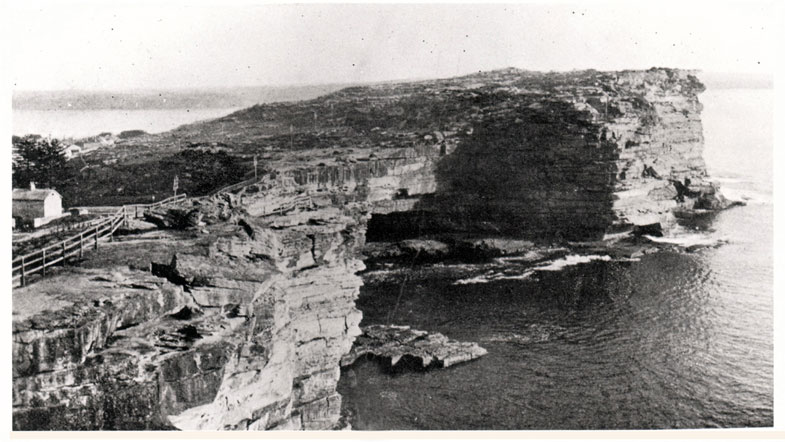
The Gap, Watsons Bay c1908. Woollahra Libraries Digital Archive pf000628
Elizabeth Macarthur died at Clovelly, following a stroke, in February 1850. The announcement of her death in the Sydney Morning Herald was without fanfare:
On the 9th instant, at Clovelly, the residence of H. Watson Parker, Esq., Elizabeth, widow of the late John Macarthur Esq., of Camden, aged 83 years.
(Sydney Morning Herald 16.2.1850 p. 3)
No obituary or article marking her death has been traced in the main Sydney newspapers of the day; she received no official honours in life, and the only monument to her is one eventually placed by her family over her final resting place.
However, as her reputation grew and her impact on the colonial world became better known in the century following her death, her name came to be used commemoratively. In 2018 in New South Wales it is remembered by the Elizabeth Macarthur Agricultural Institute at Menangle, and the Elizabeth Macarthur High School at Narellan, by an avenue in Camden and by Elizabeth Macarthur Park at Parramatta. All are fitting subjects to carry her name as they represent her warm interest in children and the young, her enthusiasm for horticulture and agriculture, and her sentiment for this western district of Sydney.
From Watsons Bay, Elizabeth Macarthur’s body was returned to Elizabeth Farm, but then taken for burial to Camden Park, where her remains were placed beside those of her late husband – in whose legacy as founder of the Australian wool industry she had won the right to a share. Quite apart from her work and her talents, John Macarthur had benefited from the great respect in which his wife was universally held, and which translated to a future high regard for the couple’s children, in which did they not disappoint.
Elizabeth’s life’s work had left behind economic security for her own family, and a pioneering contribution to the economy of the infant colony of New South Wales. Not only in wool, but in other areas of agriculture (such is viticulture) she or her descendants have played a leading role. In terms of tangible heritage, Elizabeth Farm and Camden Park survive today.
Also left behind her is a weight of writing encompassing sixty years of records and observations of life the early European settlement. This work provides not only a window into her immediate world of hearth, home and pastoral estates. She offers also a broader and lively view of the colony – its social fabric, main players, and happenings, from routine to extreme, such as her first-hand account of the 1804 ‘Vinegar Hill’ (Castle Hill) rebellion.
Michael Flynn, who has analysed many sources to tell the story of the Second Fleet, cites Elizabeth’s shipboard journal as ‘a valuable supplement’ to other sources, but comments
She makes almost no mention of the convicts and their suffering, beyond complaining of the bad language and impertinence of the convict women.
(Flynn, Michael The Second Fleet p.414)
However, to be fair to Elizabeth, she had not set out to recount the experiences of others, and in recording her own she had vicariously shed a most effective light on the obverse to her personal suffering – the wretched plight of the women on the ‘other’ side of the partition. The stench and the screams which unsurprisingly offended her, obviously had their origin in the horrific circumstances of others, and serve to reinforce the record. Her more particular experiences, as recounted, under the command of Captain Traill add to the portrait of a man later found to have sold at inflated prices the rations withheld from his human cargo.
Elizabeth’s character and opinions were shaped by, and reflect, her era and upbringing. The views which she privately held towards the convicted and the indigenous were all but inevitable, yet episodes from her life show that this did not prevent her from acts of friendliness and kindliness which flouted social convention. Her calm determination to seek the positive aspects of a situation, find purpose, and resiliently take on onerous and difficult work when challenged, are qualities easily understood and respected in any age.
Published works
- Bickel, Lennard Australia’s first lady : the story of Elizabeth Macarthur Allen & Unwin, 1991.
- Conway, Jill ‘Macarthur, Elizabeth (1766–1850)', Australian Dictionary of Biography vol. 2 Melb. Univ. Pr., 1967.
- Flynn, Michael The Second Fleet: Britain’s grim convict armada of 1790. Syd., Library of Australian History, 1993.
- King, Hazel Elizabeth Macarthur and her world Syd., Syd., Univ. Pr. 1980
- Martin, Megan A Thematic History of Watsons Bay Syd., Architectural Projects, 1997.
- Some early records of the Macarthurs of Camden/ ed. By Sibella Macarthur Onslow Syd., A & R 1914
- Scott Tucker, Michelle Elizabeth Macarthur, a Life at the Edge of the World Publisher: Text Publishing, 2018
- Steven, Margaret, 'Macarthur, John (1767–1834)', Australian Dictionary of Biography vol. 2 Melb. Univ. Pr., 1967.
Unpublished sources or archive collections
- Trove – Newspaper collections, National Library of Australia
Footnotes
i Elizabeth Macarthur’s most recent biographer, Michelle Scott Tucker, visited places associated with Elizabeth Macarthur and posted blog accounts of her findings.
ii Present-day photograph of Lodgeworthy posted by Michelle Scott Tucker
iii Conway, Jill ‘Macarthur, Elizabeth (1766–1850)', Australian Dictionary of Biography vol. 2 Melb. Univ. Pr., 1967.
iv Steven, Margaret, 'Macarthur, John (1767–1834)', Australian Dictionary of Biography vol. 2 Melb. Univ. Pr., 1967 – the quote also covered in some detail by King, Hazel Elizabeth Macarthur and her world, pp 8-9.
v King, Hazel Elizabeth Macarthur and her world p. 8
vi Elizabeth did disapprove of a third marriage made by the twice-widowed Grace, believing it beneath her mother, but it did not ruin their own relationship, and in Grace’s dotage she arranged for an allowance of £50 p.a. to be paid to Grace, which John Macarthur quietly increased to £75 – evidence that he could be a generous benefactor who sought no reward. King, Hazel Elizabeth Macarthur and her world pp. 160-162
vii Penelope Lucas had initially been engaged by John in London to educate Elizabeth, the firstborn of the Macarthur daughters, and then travelled to Sydney with John to continue her educative role in the household at Elizabeth Farm, John and Elizabeth Macarthur’s Parramatta estate. Bickel, Lennard Australia’s First Lady p. 93
viii Later General Sir Edward Macarthur CB, KCB Administrator of Victoria, 1855-1856.
ix Parsons, Vivienne 'Nepean, Evan (1752–1822)', Australian Dictionary of Biography vol. 2 Melb. Univ. Pr., 1967.
x Bickel, Lennard op. cit.p. 17
xi ‘Dear Devon, there is much that is so agreeable in the county but surely the entrance to Plymouth by sea must surpass all other beautiful scenes.’ Quoted in Bickel, Lennard Australia’s First Lady p.18
xii Quoted in Scott Tucker, Michelle Elizabeth Macarthur: A Life at the Edge of the World – citation from Macquarie, Elizabeth In her own word: the writings of Elizabeth Macquarie/ ed by Robin Walsh Syd., Macquarie Univ. Pr. 2011 p.44
xiii Macquarie, Elizabeth In her own words: the writings of Elizabeth Macquarie/transcribed and edited by Robin Walsh Syd., Macquarie Univ. Pr. 2011 pp.224-225.
xiv Fletcher, B. H. 'Grose, Francis (1758–1814)', Australian Dictionary of Biography vol. 1 Melb. Univ. Pr., 1966.
xv Bickel, Lennard Australia’s First Lady p. 40
xvi Bickel op.cit p. 57
xvii Bickel op.cit p. 55-56
xviii A grant of 5,000 acres - halved from the 10,000 acres urged by John’s powerful friend Lord Camden by the intervention of Joseph Banks, with whom Macarthur had quarreled - but eventually increased to three times that size by further grants and purchases.
xix King, Hazel Elizabeth Macarthur and her world pp. 20-21
xx MacArthur, John Memorial to Lords of the committee of the Privy Council London, January 1804 quoted in Bickel op.cit p. 67
xxi Although of Scottish descent as his name implies, Gordon was in the service of, and with allegiance to, the Netherlands.
xxii Bickel op.cit p. 67
xxiii Bickel op.cit p. 6
xxiv From 1804, Secretary of State for War and the Colonies.
xxv Bickel, Lennard Op.cit pp.131-132.
xxvi Raised to 4-storey height in the 1890s
xxviiSydney Gazette 29.8.1835 p. 3
xxviiiThe Australian 24.11.1837 p. 3
xxix LTO Book M No 729 – cited in Martin, Megan A Thematic history of Watsons Bay. Syd., Architectural Projects 1997p. 17
xxx Latta, David Lost glories Ryde., A&R, 1986 p. 84
xxxi Emmeline Macarthur had married Henry Watson Parker in 1843 in the face of maternal opposition. Parker served briefly as Premier (1856-7) and was knighted in 1858.
xxxii King Op. cit p.201
New plaques are added based on nominations from the community, which are then assessed against selection criteria and researched by a Local History Librarian.
Find out more and nominate a person or event for a plaque.